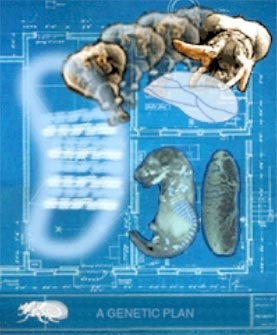Concept 37 Master genes control basic body plans.

The development of an organism — from a fertilized egg, through embryonic and juvenile stages, to adulthood — requires the coordinated expression of sets of genes at the proper times and in the proper places. Studies of several bizarre mutations in the fruitfly, Drosophila, provided keys to understanding the molecular basis of large-scale developmental plans. Early embryonic genes express proteins that set up the orientation and define the body segments of the fly embryo. Then "homeotic" genes act on the segments to make the body parts distinct to each segment.
Sequence analysis showed that homeotic genes from Drosophila and vertebrate animals share a 180-nucleotide region, called the homeobox. These homeobox proteins have structures highly similar to the regions of regulatory proteins that bind to DNA promoters and enhancers. Thus, a homeotic protein elicits coordinated expression when the protein binds to a specific promoter or enhancer sequence shared by a number of genes involved in the development of body region or segment.
 DNA is packaged in a chromosome.
DNA is packaged in a chromosome. Higher cells incorporate an ancient chromosome.
Higher cells incorporate an ancient chromosome. Some DNA does not encode protein.
Some DNA does not encode protein. Some DNA can jump.
Some DNA can jump. Genes can be turned on and off.
Genes can be turned on and off. Genes can be moved between species.
Genes can be moved between species. DNA responds to signals from outside the cell.
DNA responds to signals from outside the cell. Different genes are active in different kinds of cells.
Different genes are active in different kinds of cells. Master genes control basic body plans.
Master genes control basic body plans. Development balances cell growth and death.
Development balances cell growth and death. A genome is an entire set of genes.
A genome is an entire set of genes. Living things share common genes.
Living things share common genes. DNA is only the beginning for understanding the human genome.
DNA is only the beginning for understanding the human genome.